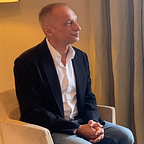Celebrating Gaja: the vineyard that put Italian wine back on the map — Kay Rieck
If you achieve success, the temptation can be to keep doing the same thing and assume you will have more success. Sometimes this strategy can pay off, but, more often than not, whether you are talking about business or wine, innovation is a better pathway to success. The Gaja vineyard represents a superb example of this, suggests wine enthusiast Kay Rieck.
Gaja, a wine making family from the Italian Piedmont that is steeped in history, has found a way to bring together innovation and tradition in perfect balance. With a history of superb food and wine production stretching back to the mid-nineteenth century, many vineyards would be content to quietly keep producing superlative wines that command excellent investment prices. Not so with Gaja, which has spent the last four decades innovating and bringing the spotlight back onto Italian wines.
The best fairy tales have some darkness
When you read the bullet points of the Gaja story, it reads like a fairy-tale family history. The Gaja family can trace its ancestry back to its arrival in Italy from Spain in the 17th century, starting its assent from a tavern where it served its wine alongside its food, before upping its production to supply wine to the Italian Army in Abyssinia just before the turn of the 20th century. Towards the end of the 1930s, the wine began to be emblazoned with the family name on its bottles, a branding strategy that exists until now, and it purchased several vineyards in the late 1940s, building a strong reputation among wine enthusiasts and traders.
While it may all sound like the kind of fairy-tale family history that underpins many of the oldest wine-producing families, it might not be too far from the truth to say that family tension drove the company forward and helped it move its ambitions into reality.
In the mid-eighties, for example, Angelo Gaja experimented with bringing Cabernet Sauvignon grapes to the slopes of Italy, not because he had any great love of the grape, but because he saw it as a way of proving that Italy could produce exceptional wines. This led to him developing Darmagi Cabernet, so named because his father on first tasting the wine is said to have proclaimed “what a pity”. Despite this initial reception by one of the leading figures in viniculture of the preceding generation, the wine has gone on to enjoy legendary status, and Angelo has continued to experiment successfully during his tenure running the family’s vineyards.
His influence has been a major factor in the renaissance of Italian wine over the last thirty years, with some vineyards taking and adapting his methods and others doubling down on the traditional methods. Either way, he has been the catalyst for a surge in interest in wines from the Piedmont
History keeps happening
His success has meant that the family now has the capacity to extend its activities right across Italy, but the commitment to the core range remains strong and is why these days Gaja’s wines are held in the same esteem as Château Lafite-Rothschild or Krug. This also means that they tend to hold their value from an investment perspective.
Wine is often a generational business, of course, and now Angelo’s daughters are bringing their perspectives and techniques to the vineyard. There have been fascinating changes made to the way that the family operates its vineyards that have led to significant enhancements in soil quality, a reduction in the use of pesticides and better management of water. Angelo seems to have learned from what some have described as his slightly tense relationship with his father and given his daughters’ innovations his blessing. Having made his family vineyard into one of the most respected in the world through innovation, how could he do any less?
According to press interviews the family have given recently, they take a two-fold approach to any venture: a strong belief and a strong aspect of doubt. Believe in what you are doing, but never stop asking questions. This seems like a healthy approach to take to any venture.
About the author
Kay Rieck has been an investor for more than two decades. He was a financial advisor and stockbroker on the New York Stock Exchange (NYSE) for many years.
Kay Rieck is a wine lover. He discovered his love for wine by chance at a tasting, like many wine lovers before him.
He then met Karl, with whom a wonderful friendship developed.
Karl is an accomplished sommelier with a refined but sharp palate. For several years, they bought exceptional wines and built bottle by bottle, neck by neck an extraordinary cellar of Bordeaux, Burgundies, Italian wines and some Champagnes together.
